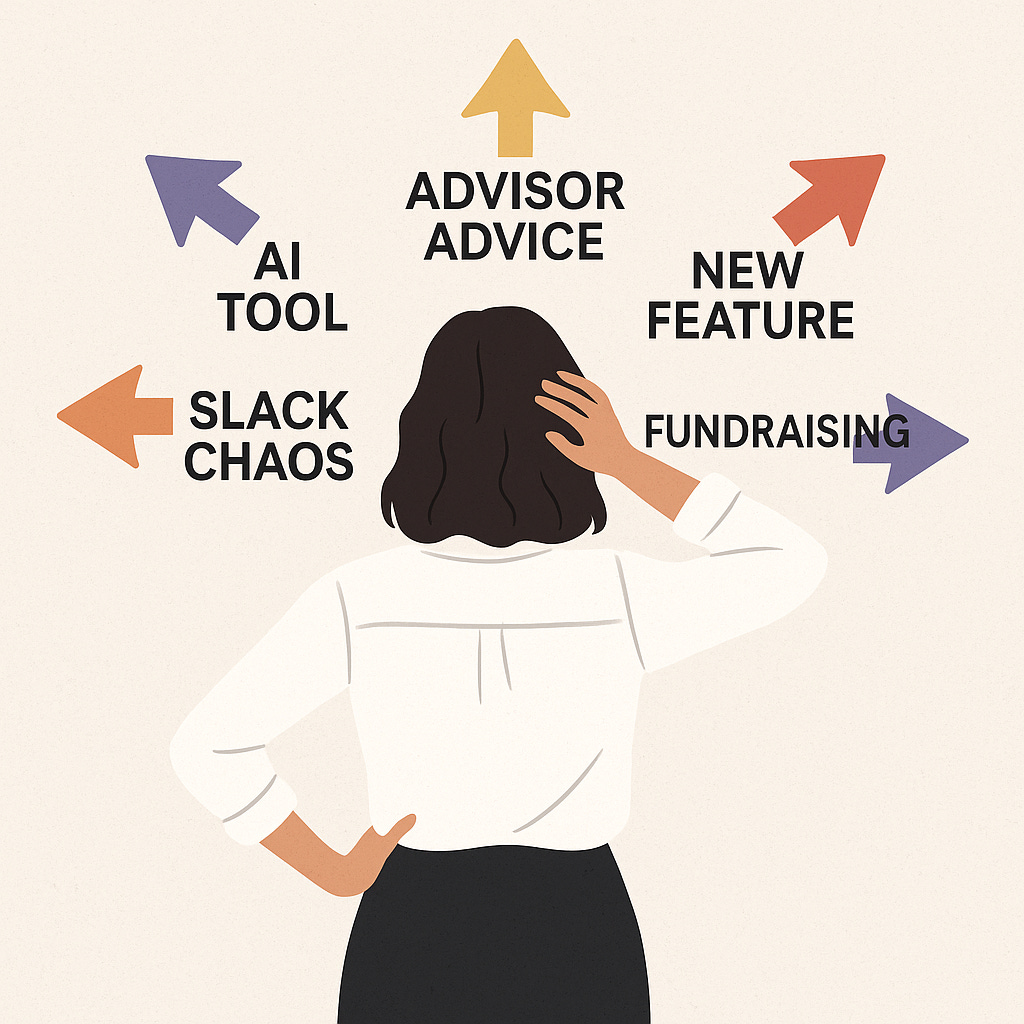It literally just happened again on a discovery call.
The founder leaned back, half laughing, and said: “I think I have ADD.”
I hear this more often than not. Sometimes it’s serious, sometimes it’s a joke. Either way, I just laugh inside and think: Okay, you just confirmed you need my ops backbone.
Why Founders Skew ADHD-ish
The signs are everywhere.
A founder sets up a roadmap, it’s looking sharp, and then someone mentions a new AI tool. Suddenly, the product and engineering teams are being told to pivot everything toward putting AI in the system. Simply because it is AI, and that is such a buzzword right now. It doesn’t matter that this totally blows up the other roadmap plans paying clients have requested.
Other times, they change course after one advisor’s offhand comment. Or they loop in the wrong stakeholder, keep ten side conversations going in Slack, and confuse the team about which direction is real.
It’s mayhem, but it’s also part of what makes founders who they are and why they can be so successful.
Research has shown that entrepreneurship and ADHD share common traits, including impulsivity, novelty-seeking, quick pattern recognition, and comfort with risk (Michael Freeman’s study on founder mental health).
These traits are often the reason startups exist in the first place.
The willingness to pivot, take risks, and chase ideas is exactly what drives innovation.
As Jenna Kutcher put it after her ADHD diagnosis, “So many of the systems I had built in my life and business were adaptations for ADHD. This brain? It’s scrappy, solution-oriented, and wildly resourceful.” (Full article here)
That’s exactly the energy I see in founders…scrappy, full of ideas, and resourceful.
What’s the problem then? Without the right backbone, that same energy derails teams.
The Cost of Shiny Object Syndrome
I’ve seen this firsthand.
At one company, we spent hours doing feature prioritization (using a scoring framework called RICE (Reach, Impact, Confidence, Effort)) to clearly identify the highest ROI features.
Then the founder would hear one new idea from an advisor, and suddenly everything was up for grabs. Side meetings popped up. Slack threads contradicted each other. The roadmap stalled. Onboarding for major clients stalled. The whole company stalled.
Seed-to-Series B companies don’t have the capacity to chase every idea. When focus disappears, progress disappears.
The team feels it… hard.
Imagine being on track, making progress, and then walking into a meeting where the founder has moved the goalposts again. You can’t feel successful. You can’t feel safe or heard.
Startup life will always have some chaos, but the goalpost has to stay still sometimes.
The Counterbalance (Where I Come In)
This is where I step in.
My job as a fractional COO is to be that operational backbone. The steady hand. The buffer between founder brain and team burnout.
Here’s what that looks like in practice:
In 1:1s, I create structure and accountability plans from day one.
We set a rule: unless there are multiple signals and data pointing to a change, we stick with the plan.
I keep new ideas with the founder until they’re fully fleshed out, instead of letting them leak into the team and create chaos.
I use Notion documentation and clear accountability to anchor decisions.
Most importantly, I handle it like a human. It’s not about killing ideas, but about channeling them at the right time, with the right process.
A Practical Trick for Focus
Here’s one simple exercise founders can try tomorrow:
Ask yourself: What does success look like in 90 days?
Then ask: Does this new idea move us closer, or does it distract us?
It sounds simple, but it’s one of the fastest ways to sort shiny-object syndrome from true opportunity.
If you want more ADHD-friendly strategies, ADDitude Magazine and CHADD.org both have practical tools you can borrow and adapt for founder life. Books like ADHD 2.0 by Edward Hallowell or The Distracted Mind by Adam Gazzaley also dig into the science of focus in modern work.
Founders with ADD energy aren’t broken; in fact, they’re visionary. But when every idea gets airtime, the company spins its wheels.
The good news? You don’t have to change who you are. You just need a backbone alongside you.
That’s the role I play. The operational backbone that lets you keep innovating without leaving your team spinning in circles.
And if you read this thinking, “Oh boy, that is totally me — I’d be in such a better place if I had a Katie at my side” … you’re probably right. 😉
👉 Take my Clarity Diagnosis to spot where shiny object syndrome is slowing you down.




This is great, so relatable for the people I work with but also myself.
I love this perspective, and can 100% relate! Well said!